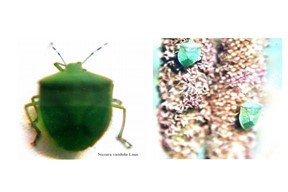Qualitative detection of different enzymes from the gut and salivary glands of Nezara viridula Linn. using the chemical inference
Abstract
Globally the crop insect pests damage the 30% of agriculture production due to insect spoil, and the situation is very awful in particularly developing countries such as India. There are large number of insect pest families are well known which induce the critical destroy to agriculture crops. Crop insect pest’s harm is one of the significant features that ruin the agriculture crop productivity, although the large-scale utilization of chemical pesticides. The successfulness of the pesticides depends upon the interaction of chemicals with the physiology of the insect of the pests. In India, the Nezara viridula Linn, is one of the critical insects because of its destructive feeding on major crop which is the utmost source of economic deprivation in agriculture. The enzymes present in the gut and salivary glands of the N. Viridula play key role in the feeding behaviour. Presently very little is investigated about the gut and salivary glands of the N. Viridula at minute level. We first time investigated the different enzymes existing in the gut and salivary gland using the chemical inference. This research work is carried out to analysis the enzymes for digestive and feeding behaviour of N. Viridula which will assist the biologists to manage the challenges are created by their resistance to the traditional chemical insecticides used for prevention of N. Viridula (a type of southern green stink bug) inhabitants and high reproductive amplitude. The extensive statistics of invertase enzymes, maltase, alpha galactosidase, amylase, esterase, proteinase and polypeptidase enzymes for the N. Viridula in salivary glands and gut inspired by this research imparts supplementary resource for further understanding of the biology of this Pentatomidae (Heteroptera) species.
Keywords:
Chemical inference, Gut enzymes, Nezara viridula Linn, Salivary glandsDownloads
References
Banik, S., Biswas, S. and Karmakar, S. (2018). Extraction, purification, and activity of protease from the leaves of moringa oleifera, F1000 Research, 7: 1151
Dhaliwal, G.S., Jindal, V. and Mohindru, B. (2015). Crop losses due to insect pests: Global and Indian Scenario, Indian Journal of Entomology, 77: 168-168.
Ewunkem, A.J., Sintim, H.O., Dingha, B.N., Gyawaly, S. and Jackai, L.E. (2020). Nutritional ecology of the southern green stink bug Nezara viridula (Hemiptera: Pentatomidae) on selected varieties of cowpea and tomato. American Journal of Entomology, 4: 1-9.
Farris, M.H., Ford, K.A. and Doyle, R.C. (2016). Qualitative and quantitative assays for detection and characterization of protein antimicrobials. Journal of Visualized Experiments, 110: 53819
Lushchaka, V.I., Matviishyna, T.M., Husaka, V.V., Storey, J.M. and Storey, K.B. (2018). Pesticide toxicity: a mechanistic approach. EXCLI Journal, 17: 1101-1136.
Nicol, J., Turner, D., Coyne, L., den Nijs, L., Hockland, S. and Maafi, Z. (2011). Current nematode threats to world agriculture. Genomics and Molecular Genetics of Plant-Nematode Interactions, Berlin: Springer Science Business Media, 2: 21-43.
Otín, C.L. and Bond, J.S. (2008). Proteases: multifunctional enzymes in life and disease. The Journal of Biological Chemistry, 283: 30433–30437.
Panizzi, A.R. (1997). Wild hosts of pentatomids: Ecological significance and role in their pest status on crops. Annual Review of Entomology, 42:99–122.
Sasser, J.N. and Freckman, D.W. (1987). A world perspective on nematology: The role of the society. Vistas on Nematology; Society of Nematologists, Inc., Hyattsville, MD 6: 7-14.
Singh, S.M., Pathak, S.C., Kulkarni, N., Naidu, J. and Dubey, V. (1991) First report of phaeohyphomycosis of Nezara viridula Linn. (Insecta: Heteroptera) caused by Curvularia lunata. Mycopathologia, 116: 37–43.
Swingle, H. S. (1925). Digestive enzymes of an insect.
Thomson, D.L. and Collip, J.B. (1932) The parathyroid glands. Physiological Reviews Vol. XII: 309-314
Tillman, P.G., Northfield, T.D., Mizell, R.F. and Riddle, T.C. (2009) Spatiotemporal patterns and dispersal of stink bugs (Heteroptera: Pentatomidae) in peanut-cotton farmscapes. Environmental Entomology, 38: 1038-1052.
Todd, J.W. (1989) Ecology and behaviour of Nezara viridula. Annual Review of Entomology, 34: 273-292.
Will, T. Furch, A.C.U. and Zimmermann, M.R. (2013). How phloem–feeding insects face the challenge of phloem– located defenses, Front Plant Science, 4: 336-12.

Published
How to Cite
Issue
Section
Copyright (c) 2020 Agriculture and Environmental Science Academy

This work is licensed under a Creative Commons Attribution-NonCommercial 4.0 International License.

